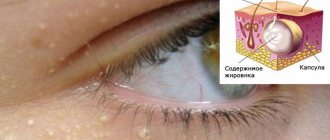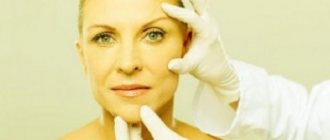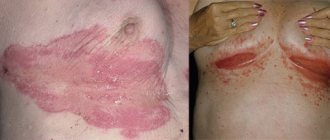Blepharitis is an eye disease in which the eyelids become very swollen and red. Each type of blepharitis has its own characteristic symptoms. Treatment can take from two weeks to two months, so it is important to contact a specialist in time to prevent complications. We will tell you in the article how different types of this pathology are treated.
In this article
- Signs of blepharitis
- What causes the development of blepharitis of the eyelids?
- What types of blepharitis are there?
- Treatment of blepharitis
- Rules for the use of drugs
- Physiotherapy for the treatment of blepharitis
- What additional measures should be taken when treating blepharitis?
- What are the consequences of untimely treatment?
Blepharitis usually affects the upper and lower eyelids. After diagnosis, the doctor will determine the cause of the disease - based on this, effective medications are prescribed. Too long a course of the disease can lead to unpleasant complications: the appearance of chalazion, barley, the development of keratitis or conjunctivitis, and also deteriorate the quality of vision. When the first symptoms of blepharitis appear, you should immediately begin treatment. How to recognize them?
Signs of blepharitis
This ocular inflammation is characterized by the following clinical manifestations:
- fatigue even with little eye strain;
- thickening and redness of the edges of the eyelids;
- noticeable itching and irritation of the organs of vision;
- increased sensitivity to light;
- sticky discharge or pus that sticks to eyelashes;
- the appearance of scales and crusts on the upper and lower eyelids;
- eyelash loss.
These symptoms apply to many types of blepharitis. If they appear, you should immediately contact a specialist - he will establish a diagnosis and prescribe competent therapy. For a speedy recovery, you must strictly adhere to medical recommendations, observe personal hygiene and the prescribed treatment regimen.
Prevention
Often, peeling and many ophthalmological disorders are easier to prevent than to eliminate later. To do this, you need to follow the following recommendations:
- exclude possible allergens;
- replace contact lenses on time (after any infectious diseases, be sure to purchase a new pair);
- use high-quality decorative cosmetics, cleansers and care products;
- remove makeup every evening;
- spend less time at the computer, take regular breaks from work;
- humidify the air in the room;
- do not touch your eyes with dirty hands.
Peeling skin can occur due to frequent stress or lack of vitamins. To prevent the problem, you need to eat foods that contain substances beneficial to the skin:
- dairy products;
- fish;
- liver;
- nuts;
- fresh seasonal fruits and vegetables;
- lean meat;
- liquid (pure water, herbal teas) in an amount of 2 liters per day.
To normalize your emotional state and sleep, it is recommended to drink tea with chamomile and mint, boiled milk with honey at night.
What causes the development of blepharitis of the eyelids?
Factors that cause non-infectious blepharitis of the lower or upper eyelid are various allergens, including mites. The allergic type of blepharitis begins to develop from the entry into the eye structures of substances that irritate them: cosmetics, household chemical liquids, aerosols, particles of flowering plants. Pet owners can get demodectic blepharitis: it is caused by the Demodex mite, which lives on the fur of pets.
Even visual impairment can cause inflammation of the upper and lower eyelids. Thus, blepharitis often occurs in people diagnosed with farsightedness or astigmatism. The risk group includes people with diseases of the nasopharynx - sinusitis, tonsillitis, as well as general pathologies: diabetes mellitus, gastritis, cholecystitis, etc. Weakened immunity, sensitive and dry organs of vision, chronic intoxication, lack of vitamins important for the eyes can also cause the disease.
Use of flavoring for carp
But again, this division is rather arbitrary. Fishermen often follow not instructions, but their own experience and vision of the “correct” smell for carp or other fish. They use not only different aromas and their concentrations, but also make all kinds of mixtures from additives, combining aromas.
You need to understand that there is no “wonderful” or “super” carp flavoring or dip that will work always and everywhere. For the time of year, day, specific body of water and fish, you need to choose your “key” in the form of a scent. Therefore, the variety of odors among carp attractants is simply amazing. These smells are not always even pleasant for humans, and sometimes even exotic.
If an angler fishes in the same body of water and has chosen his working scent, then this will increase the effectiveness of bait and bait by about a quarter, but no more, and this does not always work. If the carp has fallen to the bottom and is on strike, then even the “stinkers” will not help.
Most often, amateur fishermen, after trial and error, select one, two or three scents or mixtures of scents and use it from spring to autumn. Moreover, the manufacturer is not as important here as professional fishermen “gurus” try to explain to us.
They all work for various companies and advertise their products. And today the choice of manufacturers is huge and you can choose a dip, attractant, etc. for a lower price
no worse (I don’t take into account the outright nameless “cheap”). You just have to try, but try to ignore advertising like: “Use only our “stinkers” because they are the most attractive”
Let's try to understand modern smells for carp fishing and give the main “folk” ones, i.e. “carp” aromas.
What types of blepharitis are there?
Depending on the pathogen that caused inflammation of the eyelids, blepharitis is divided into types and, depending on this, medications are prescribed.
Seborrheic or scaly blepharitis
The most common form of the disease. Its symptoms: the formation of dry yellowish scales in the interciliary space, the release of a sticky secretion that glues the eyelashes, swollen and reddened eyelids, profuse lacrimation. With a long course of the disease, some areas of the head may be affected by seborrheic dermatitis.
Ulcerative blepharitis
A severe form of the disease caused by Staphylococcus aureus. Usually difficult to treat. Signs of the disease are the release of pus from the hair follicles of the eyelashes, the formation of ulcers at their roots, and in the acute form - active loss of eyelashes. After recovery, their proper growth may be disrupted, and scars from healed ulcers may remain.
Allergic blepharitis
It develops most often during the flowering period of plants, and can also be a consequence of the reaction of the organs of vision to cosmetics, household chemicals and other components that irritate the mucous membrane. Sometimes drug-induced blepharitis, which occurs as a result of taking certain medications (externally or internally), is also classified as allergic.
Demodectic blepharitis
The causative agent of this form of the disease is the Demodex mite. It causes severe itching and burning, especially in the morning after waking up. Sebaceous secretions and particles of the epidermis accumulate at the edge of the eyelashes.
Meibomian blepharitis
The excretory ducts at the base of the eyelashes become clogged with sticky secretions, the edges of the eyelids become red and inflamed, and purulent blisters form on them. After opening them, small scars remain, which disappear some time after complete recovery. Depending on the location of the affected areas, blepharitis is divided into three categories:
- anterior marginal, in which the inflammatory process spreads to the edges of the eyelids along the ciliary row;
- posterior marginal, affecting the meibomian glands;
- angular, in which inflammation occurs in the corners of the eyes.
If you find any of the listed signs in yourself or your child, you should immediately contact a specialist. If blepharitis of the eyelids goes from a chronic stage to an acute stage, then it will be more difficult to cure it. Effective therapy requires strict adherence to the rules of personal hygiene and diet, as well as strict adherence to the prescribed therapeutic regimen and compliance with all doctor’s recommendations.
Prognosis for recovery from melanoma of the eyelid
In general, eyelid melanoma is an aggressive tumor and is diagnosed at late stages, when the prognosis for treatment is unfavorable. Five-year survival can be achieved in only half of the patients. But in the initial stages, with a melanoma thickness of less than 0.75 mm, the chances of a complete recovery are much higher.
| Read more about dermatological research at Euroonko | |
| Consultation with a dermatologist-oncologist | from 5,100 rub. |
| Skin examination using the German FotoFinder device | RUB 13,400 |
| Diagnosis of melanoma | from 5,100 rub. |
Book a consultation 24 hours a day
+7+7+78
Treatment of blepharitis
To treat infectious types of blepharitis, corticosteroid drugs and antibiotics are used - this regimen is most effective. Antibacterial ointments and drops are presented on the pharmaceutical market in a large assortment. Each remedy has its own active ingredient that suppresses pathogens. Here are some of them that can be prescribed for the treatment of blepharitis.
- "Tetracycline"
An inexpensive, well-known antibiotic that shows good results in the treatment of blepharitis, as well as conjunctivitis, keratitis, barley and other eye diseases. Tetracycline ointment must be used strictly in accordance with the treatment regimen determined by the doctor. It depends on the type of blepharitis, the degree of damage to the visual organs and the individual characteristics of the body.
- "Tobrex"
The active substance, tobramycin, is effective in the treatment of infectious eye diseases. Tobrex is convenient because it has almost no contraindications: it can even be prescribed to children and pregnant women at the discretion of the doctor.
- "Maxitrol"
The active ingredients of these drops are dexamethasone + neomycin + polymyxin B. They are effective in the treatment of blepharitis, conjunctivitis, iridocyclitis, keratitis, and are also prescribed during the rehabilitation period after eye surgery to prevent the development of infections. May cause increased intraocular pressure and other adverse reactions.
- "Gentamicin", "Dex-gentamicin"
The main active ingredients are gentamicin, gentamicin + dexamethasone. Ointments have antiallergic, anti-inflammatory and antibacterial effects. They are used in the treatment of many eye diseases, including blepharitis of the upper and lower eyelids. Contraindicated for viral inflammation of the cornea and conjunctiva, increased intraocular pressure and a number of other conditions.
- "Normax"
Antibacterial agent from the group of fluoroquinolones. The active ingredient is norfloxacin. Not recommended during pregnancy, lactation, or children under 18 years of age. Adverse reactions: nausea, headache, dizziness and others.
- "Levomycetin" (ointment, drops)
The ointments and drops contain broad-spectrum antibiotics, including chloramphenicol. Used for conjunctivitis, blepharitis, keratitis and other eye diseases.
- "Erythromycin"
The main components of the ointment are broad-spectrum antibiotics. Used for various eye diseases. Sometimes they may not act effectively enough due to the fact that some pathogenic bacteria have developed resistance to them, since drugs based on erythromycin have been used for several decades.
- "Signitsef"
Antibacterial drops from the fluoroquinolone group. It is used to treat conjunctivitis, blepharitis, keratitis and other diseases, as well as to prevent complications after eye surgery. Sometimes it can cause decreased visual acuity, discomfort, dry eye syndrome and a number of other side effects. Contraindicated during pregnancy, breastfeeding, and children under 1 year of age.
- "Oftocipro", "Tsiprolet" "Tsipromed", "Ciprofloxacin"
The active component of these drugs is ciprofloxacin. Used to treat blepharitis, conjunctivitis, keratitis, bacterial corneal ulcers, chronic dacryocystitis (inflammation of the lacrimal sac) and barley. Contraindicated in viral keratitis, pregnancy, lactation, and children under 1 year of age.
Methods for treating eyelid melanoma
The standard treatment for melanoma is surgical removal within healthy tissue. However, with such a complex localization, it is not always possible to carry out a full-fledged surgical intervention, since a large defect is formed that disfigures the person’s appearance. In addition, the anatomy of the eyelid is disrupted, which leads to various consequences for the eye - constant lacrimation, inflammation, eye injury, etc. Therefore, when melanoma is localized on the eyelids, other treatment methods are used, including radiation therapy and minimally invasive surgery.
Close focus radiotherapy in the treatment of melanoma of the eyelid
The essence of the technique is to irradiate the tumor from a short distance with low voltage values. Due to this, radiation is mainly absorbed by tumor cells and minimally affects other tissues. This treatment method is effective only for small, superficial tumors. Irradiation is carried out daily up to a total focal dose of 60-80 Gy.
Radiation therapy for eyelid melanoma
Radiation therapy is the exposure of a tumor to a concentrated stream of ionizing radiation. In the treatment of melanoma of the eyelid, contact radiation therapy has become widespread. For this purpose, a special plate containing radioactive material is used. In appearance it resembles a bottle cap. It is attached to the eye and left for 4-5 days, after which it is removed. As part of radiation therapy for eyelid melanoma, external irradiation can also be used, in which ionizing radiation is generated by special devices.
Excision of melanoma with a laser scalpel
A laser scalpel involves dissecting biological tissues due to a sharp increase in temperature in a small area. This leads to the fact that the irradiated area instantly burns, coagulating proteins and “sealing” the wound. A cut 2-3 mm deep appears. To completely remove the tumor, the tissue is cut in layers. The advantage of a laser scalpel is:
- Low morbidity.
- Simultaneous sealing of vessels. This not only eliminates bleeding, but also prevents the spread of melanoma cells.
- Cells are dissected in a non-contact manner, and heating the tissue leads to the death of possible microorganisms in the wound. Thanks to this, the risks of infectious complications are reduced.
The use of electric knife in the treatment of melanoma
When using an electric knife, high voltage alternating current is supplied to the tissue. Because of this, it is locally heated and charred, which leads to the formation of a cut. At the same time, coagulation of blood vessels occurs, which reduces the risks of bleeding and hematogenous spread of melanoma cells. The advantages of this removal method are similar to those of a laser scalpel, but there are a number of disadvantages:
- Trauma to tissue during removal process. This not only leads to the development of an inflammatory response in the dissection area, but also damage to the tumor being removed, which complicates its morphological and molecular genetic testing.
- There is a high risk of keloid scar formation, which in itself is not desirable, especially if it is in the eyelid area.
- Risk of permanent scar formation.
In this regard, the use of electric knife when removing melanoma is limited.
Rules for the use of drugs
In order for the prescribed drops and ointments to act purposefully to achieve a faster effect, they must be administered correctly. So, it is more convenient to do this with a special spatula - it can be purchased at any pharmacy. You should squeeze out about 5-6 mm of ointment from the tube onto your shoulder blade, carefully pull back the lower eyelid and place the ointment there, being careful not to touch the eye tissue with the tip of the tube. Then you need to close your eyelids for a while so that the product is evenly distributed inside.
When instilling drops, make sure that they fall exactly into the conjunctival sac. Do not exceed the recommended dosage of medications, acting strictly as prescribed in the prescription. Excessive amounts of medication may harm your eyesight. It is better to instill in a horizontal position so that the liquid does not leak out.
The duration of use of antibacterial drugs is determined by the attending physician. However, a visible effect should occur within 3-4 days from the start of their use. If this does not happen, then you need to seek advice from a specialist - you may need to change your medication. It should be remembered that if antibiotics are used for too long, there is a risk of developing superinfection - the growth of pathogenic microorganisms that are immune to them, including fungi.
It contains mild, soothing herbal ingredients: green tea, chamomile, witch hazel extract, and effectively cleanses the eyelid skin of impurities. Apply a little lotion to a cotton swab and lubricate their edges at the base of the eyelash row, trying to remove all traces of discharge. After this, medications can be administered.
In the allergic form of blepharitis, moisturizing preparations that imitate natural human tears will help relieve dryness, itching, and irritation: Hilo-chest of drawers, Systane, Artelak Balance and others.
You should not make a diagnosis yourself and self-medicate by seeking advice from friends or using information from the Internet. Only a specialist, after a competent diagnosis, will select effective medications to eliminate inflammation of the eyelids. An inappropriate remedy for a particular type of blepharitis can only aggravate the course of the disease and thereby delay recovery.
Diagnosis of the disease
The first thing to do when xanthelasma manifests itself is to make an appointment with a specialist.
After a visual examination, if xanthelasma is suspected, the doctor performs diascopy. The formation is pressed down with glass to bleed it so that the yellowness appears more clearly. Examinations are needed to exclude suspicions of a malignant neoplasm, syringoma, or elastic pseudosanthoma.
Additionally, a blood test for lipid spectrum is prescribed.
It is necessary to identify the risk of developing atherosclerosis, heart attack, and hypertension.
Let's clarify
| Question | Answer |
| Is it possible for xanthelasma to degenerate into a malignant neoplasm? | The patient is not in danger of such degeneration. |
| What complications accompany plaque removal? | There may be bleeding or scarring of the skin at the site of removal. It depends on the skill of the doctor and the correct choice of method. |
| Is there a re-emergence? | Yes. To prevent this from happening, it is necessary to carry out a course of special treatment and try to eliminate the provoking factors. |
| Who is at risk? | Women, people with chronic diseases, age category over forty-five. |
| What can be a contraindication to surgery? | The procedure should be postponed for pregnant women, if there is fever or inflammation. It is not recommended to do this if you have oncology or exacerbation of chronic diseases. |
| Is it worth exposing yourself to operational risk? | It is enough to compare photos of patients before and after surgery. Moreover, the risks are minimized. |
| What should be done to prevent this manifestation? | It is important to eliminate possible causes of metabolic disorders in the body.
|
| Is it possible to use decoctions and infusions of plants in addition to medications to reduce cholesterol? | Yes. Some plants contribute to this. Have fewer side effects than chemical drugs. But it can only be used strictly as prescribed by a doctor. Along with other actions, they stimulate bile secretion, so any violations of these organs can lead to serious complications. |
| Which removal method is most popular? | The use of a laser is highly effective for any size of formation and has minimal consequences, since the integrity of the tissue is practically not compromised. The last word always belongs to the specialist. |
| Does laser pose a threat to the eyes? | The laser beam precisely targets the problem area. The mucous membranes of the organs of vision are not in danger. |
| What determines the cost of the operation? | The price for this service is dictated by the chosen removal method and the size of the growth. The larger it is, the more expensive it is. The category of specialist and the level of equipment used also have an impact. |
Physiotherapy for the treatment of blepharitis
If the disease changes from chronic to acute or the prescribed medications have a slow effect, additional physiotherapeutic procedures may be prescribed. Treatment with devices will help eliminate inflammation and redness of the upper and lower eyelids, improve metabolic processes, and accelerate the regeneration of damaged tissues. For this use:
- UHF therapy;
- darsonvalization - exposure to high-frequency pulsed current;
- electrophoresis;
- magnetic therapy and other methods.
Washing the conjunctival cavity and applying anti-inflammatory compresses to the eyelids also have a good result. The list of necessary procedures is determined by the ophthalmologist, and he also regulates their duration and period of implementation.
How to get rid of dry skin around the eyes with moisturizer
The best treatment is to eliminate the cause of dry skin. Some causes, such as eczema, have no cure. However, it makes sense to do everything you can to reduce the symptoms of dry skin around the eyes and skin of the eyelids. If the cause of your skin condition is a more serious condition such as blepharitis, you should consult your doctor.
One way to treat itchy dry skin around the eyes is to use a moisturizer after washing your face with a mild cleanser. A moisturizer will provide quick relief from dry skin symptoms.
It is important to remember that you need to moisturize your skin immediately after washing to “lock in” the moisture.
Before using any moisturizer, you should perform a small test to make sure there is no allergic reaction.
Aloe Vera is better than drugstore cream for dry skin around the eyes
Aloe vera acts as a gentle moisturizer that can help repair the damage done to dry skin around the eyes. Its antimicrobial properties may help speed up wound healing. Additionally, aloe vera can help treat medical causes of dry skin around the eyes and eyelids, such as psoriasis and seborrheic dermatitis.
You can apply aloe vera directly to the dry and flaky skin around your eyes, being careful not to get the product into your eyes. Use “pure” aloe vera gel for the most effective treatment. Simply apply a small amount of aloe vera to the skin around your eyes as well as your eyelid and let it absorb into your skin. You don't need to rinse it. Do this daily to soften your skin and speed up the healing process for dry skin.
Extra Virgin Coconut Oil for Dry Eyes
Extra Virgin Coconut Oil is another effective natural moisturizer for dry skin around the eyes. It can also soften the skin and reduce flaking. Coconut oil is able to penetrate the skin and provides deep hydration to the skin while maintaining a protective layer on the epidermis.
How to Get Rid of Dry Eye Skin with Coconut Oil
Apply coconut oil to the affected areas of skin near your eyes several times a day, and before going to bed. You can also use coconut oil to moisturize dry skin on your eyelids. This will help reduce itching and flaking of the eyelids. You can also slowly massage the oil into your skin. In small quantities, coconut oil is almost completely absorbed into the skin, leaving no greasy residue.
Another way to use coconut oil for dry skin is to mix coconut oil with aloe vera to create a natural lotion for healing ear infections and flaky skin. This mixture may also help treat causes of dry skin such as eczema.
Cocoa butter for dry skin around the eyes
Cocoa butter is another natural soothing and moisturizing agent that can relieve dry skin, preventing complications such as skin chapping. A study published in the International Journal of Cosmetic Science found that cocoa butter improved the appearance and tone of the skin.
To use cocoa butter on the delicate skin around the eyes, mix it with other beneficial products like castor oil or jojoba oil. Apply the mixture daily to hydrate the skin and treat dry and flaky skin.
You can also make this home remedy for dry eyes: 1 teaspoon coconut oil (melt first), 2 teaspoons cocoa butter, 1 teaspoon sweet almond oil. The oil mixture should then thicken. Apply to dry skin around the eyes to quickly get rid of flaky skin.
Natural oils to moisturize your skin
You can also use a solution of natural oils such as jojoba oil, sweet almond oil and avocado oil to treat dry skin. They provide a protective layer on the skin that retains moisture and prevents dry skin.
You only need a few drops of any of the above oils to keep the skin around your eyes soft and supple.
You can also mix natural oils with a drop of essential oil, such as lavender or chamomile. The soothing aroma of the essential oil will help reduce stress and can manage other skin conditions like eczema.
When using essential oils, care must be taken to ensure that the oil does not get into the eyes and cause irritation.
Reducing stress reduces dry skin around the eyes
Stress can cause flare-ups of eczema, which can cause dry and flaky skin around the eyes. Essential oils, relaxation and just a good night's sleep reduce stress and the risk of developing dry skin.
What additional measures should be taken when treating blepharitis?
During therapy, you should strictly adhere to certain rules that will speed up the results.
It is important to follow a strict diet, excluding too spicy, salty, fatty, smoked foods, and alcoholic drinks from the diet. You need to consume more foods containing healthy vitamins - retinol, riboflavin, ascorbic acid, zinc, selenium:
- retinol - wild garlic, broccoli, garlic, viburnum berries, fish oil;
- riboflavin - beef liver, cod liver, quail eggs;
- vitamin C - citrus fruits, greens, sour berries;
- selenium - nuts, legumes, some cereals, for example, buckwheat;
- zinc - seafood (kelp, shrimp), hard cheeses.
By following a diet that includes the consumption of these foods, you can significantly speed up the healing process. It will also be useful to take vitamin complexes for the eyes. The development of any infection in the body is a consequence of weakened immunity, and it needs to be strengthened.
During the treatment period, you need to change bed linen more often, especially pillowcases, and also get a separate towel for the patient. It is better to gently blot the affected eye with a disposable napkin after washing, and do not rub it with your hands. Women should avoid using decorative cosmetics. It can clog the excretory ducts, prevent the release of pus and increase inflammation. In addition, cosmetics during illness cause an allergic reaction in the eyes. A large percentage of success lies in observing simple hygiene rules and following the doctor’s recommendations.
Stages of fight and prevention of xanthelasma
The only reliable way to combat xanthelasma is to eliminate it. Only the doctor will decide which method is preferable based on the specific situation. The laser beam is one of the latest achievements of high-tech medicine. Our clinic is equipped with modern equipment, and the procedure for removing xanthelasma of the eyelids is carried out by experienced professionals. Laser removal is characterized by a minimal risk of relapse, high sterility, low likelihood of injury to adjacent skin and the absence of subsequent inflammation. Contraindications for this highly effective procedure include diabetes, pregnancy, and the presence of dangerous tumor processes.
Stages of the fight against xanthelasma:
- preparation - visiting an ophthalmologist, taking tests, choosing a removal method taking into account the indications;
- destruction of education;
- restoration with the implementation of appropriate appointments and follow-up examinations.
As preventive measures, you need to choose those that are aimed at the normal functioning of the body as a whole.
To prevent xanthelasma you should:
- monitor your weight and achieve its optimal value;
- eat wisely, including fruits, vegetables, foods with beneficial properties in your diet, reduce the consumption of flour, fatty foods, and sweets;
- stabilize your drinking regime, drink at least two liters a day;
- lead a healthy lifestyle, eliminate bad habits, stress, regularly give the body adequate physical activity;
- prevent damage to the skin;
- observe personal hygiene standards;
- strengthen immunity;
- systematically undergo preventive examinations.
What are the consequences of untimely treatment?
Blepharitis, if there is a delay in starting treatment or improper therapy, can go from chronic to acute, and then it will be much more difficult to cure it. If you have symptoms that may indicate blepharitis, you should not waste time and consult a doctor. He will find out the etiology of the disease and prescribe effective medications.
There is no need to search for a diagnosis on your own and use drops and ointments based on information from the Internet. The symptoms of different blepharitis may be similar, but they may require different medications. When carrying out treatment, the patient must responsibly follow all instructions - only careful adherence to them guarantees a successful result.
How is eyelid melanoma diagnosed?
Although eyelid melanoma is a superficial tumor that is easily accessible for visual inspection, it is not always possible to diagnose the disease at an early stage, since patients do not pay attention to it and do not go to see a doctor. Therefore, much attention is paid to self-examination. You can suspect a malignant process based on the following signs:
- The neoplasm has fuzzy, blurry edges.
- Asymmetrical shape.
- Uneven coloring of the tumor. In melanoma, areas of hyperpigmentation may be replaced by depigmented areas.
- The neoplasm increases in size.
- The skin pattern changes. Melanoma is characterized by a smooth surface; peeling or ulceration is less common.
- There is redness around the tumor.
- The melanoma itself may be itchy, painful, and cause a tingling or burning sensation.
As it grows, eyelid melanoma spreads to the underlying tissues, involving the conjunctiva, sclera and other structures of the eyeball in the process. In order to diagnose melanoma in time and begin treatment, it is necessary to regularly see an ophthalmologist, especially over the age of 50 years.
Irritation on the face in children and infants: causes
Children, and especially infants, are most susceptible to irritation on the face. Children's skin is very thin, delicate and sensitive, so it can react to any adverse effects with a rash and irritation.
The causes of irritation on the face in children are very diverse - from physiological mechanisms of adaptation to infections:
The so-called milia are small whitish or yellow rashes on the baby’s cheeks, nose, and chin. Appears from the first days of life and goes away on its own. Is a sign of the child’s adaptation to the environment
- Acne also happens in newborns. As in adults, it is associated with hormonal imbalances, but in children it only indicates that the child’s hormones are being produced and are beginning to function correctly. This rash in a child goes away on its own within a few weeks. If newborn acne lasts more than a month, this is a reason to consult a doctor.
- When teething, children often experience irritation on the chin in the form of redness. The fact is that during teething, the secretion of saliva sharply increases and, due to constant humidity and irritation of the skin, a rash appears on the chin
- Seborrheic dermatitis is another disease of infants, in which a rash appears on the scalp and forehead in the form of yellow, flaky scales. This irritation disappears on its own, up to a year of the child’s life.
- Miliaria of infants is a small rash in the form of red pimples on the neck and in all natural folds. Indicates that the baby is overheated. If you dress and cover your child according to the ambient temperature, this rash will go away quickly
- Allergic diseases (atopic dermatitis). A disease that appears in children under six months of age. It manifests itself as an itchy rash on the face and scalp. This is due to hereditary allergies or errors in the nutrition of a nursing mother (egg whites, cow's milk). This rash spreads to the head, neck, and, in older age, to the arms, legs, and torso.
- Infectious diseases - scabies, measles, chickenpox, staphylococcal and streptococcal infections
Treatment at home
If peeling and itching do not go away within a few days, and you cannot get to the doctor, then the use of the following remedies will help alleviate the condition:
- series;
- chamomile;
- yarrow;
- calendula;
- St. John's wort.
Decoctions of these herbs have a fairly strong anti-inflammatory and disinfecting effect. They are prepared according to the standard recipe:
- 1 tablespoon of raw material is placed in a glass of boiling water;
- boil over low heat for 2-3 minutes (or infuse in a thermos for several hours);
- the drug is cooled and filtered.
Next, the resulting medicine is applied to the eyelids with a cotton pad at least 4 times a day. As an alternative, it is permissible to make compresses.
Black tea is considered a proven remedy for conjunctivitis. The easiest way to use is the one that comes packaged in individual sachets - just immerse them in boiling water for a few seconds and apply them to your eyes. After five minutes, the lotion is removed.
Do not forget about one important point - treatment must be continued for another 2-4 days after the disappearance of unpleasant symptoms. When none of the above helps, go to the clinic
Of course, there is always a chance that your immunity will still win, but we do not recommend testing its strength unless absolutely necessary.
When none of the above helps, go to the clinic. Of course, there is always a chance that your immunity will still win, but we do not recommend testing its strength unless absolutely necessary.
Diagnosis and treatment of eye tumors
Typically, an eye tumor can be detected by ophthalmoscopy (examination of the fundus of the eye). To confirm and clarify the diagnosis, stages of examination are carried out
:
- Ultrasound of the eyeball
- CT scan
- Magnetic resonance imaging (MRI)
- Fluorescein angiography
- Tissue biopsy followed by histological analysis.
Modern methods of immunohistochemistry make it possible to accurately determine the nature of the tumor, and tomography - its location.










